2018 TOYOTA YARIS do it yourself maintenance
[x] Cancel search: do it yourself maintenancePage 5 of 632

5
1
7
8
6
5
4
3
2
9
YARIS_HV_OM_Europe_OM52J66E
6-1. Using the air conditioning
system and defogger
Automatic air conditioning
system .............................386
Seat heaters ......................396
6-2. Using the interior lights
Interior lights list .................398
• Interior light ....................398
• Personal lights ...............399
6-3. Using the storage features
List of storage features ......400
• Glove box ......................401
• Cup holders ...................402
• Bottle holders ................403
• Auxiliary box ..................403
Luggage compartment
features............................404
6-4. Using the other interior
features
Other interior features ........407
• Sun visors ......................407
• Vanity mirrors ................407
• Portable ashtray ............408
• Cigarette lighter .............409
• Power outlet ..................410
• Armrest ..........................411
• Panoramic roof shade ...411
• Assist grips ....................412
7-1. Maintenance and care
Cleaning and protecting
the vehicle exterior .......... 414
Cleaning and protecting
the vehicle interior ........... 419
7-2. Maintenance
Maintenance
requirements ................... 427
7-3. Do-it-yourself maintenance
Do-it-yourself service
precautions ..................... 430
Hood.................................. 433
Positioning a floor jack ...... 435
Engine compartment ......... 437
12-volt battery ................... 445
Tires .................................. 451
Tire inflation pressure........ 468
Wheels .............................. 470
Air conditioning filter .......... 474
Wireless remote control/
electronic key battery ...... 477
Checking and replacing
fuses ............................... 481
Light bulbs ......................... 486
6Interior features7Maintenance and care
Page 89 of 632
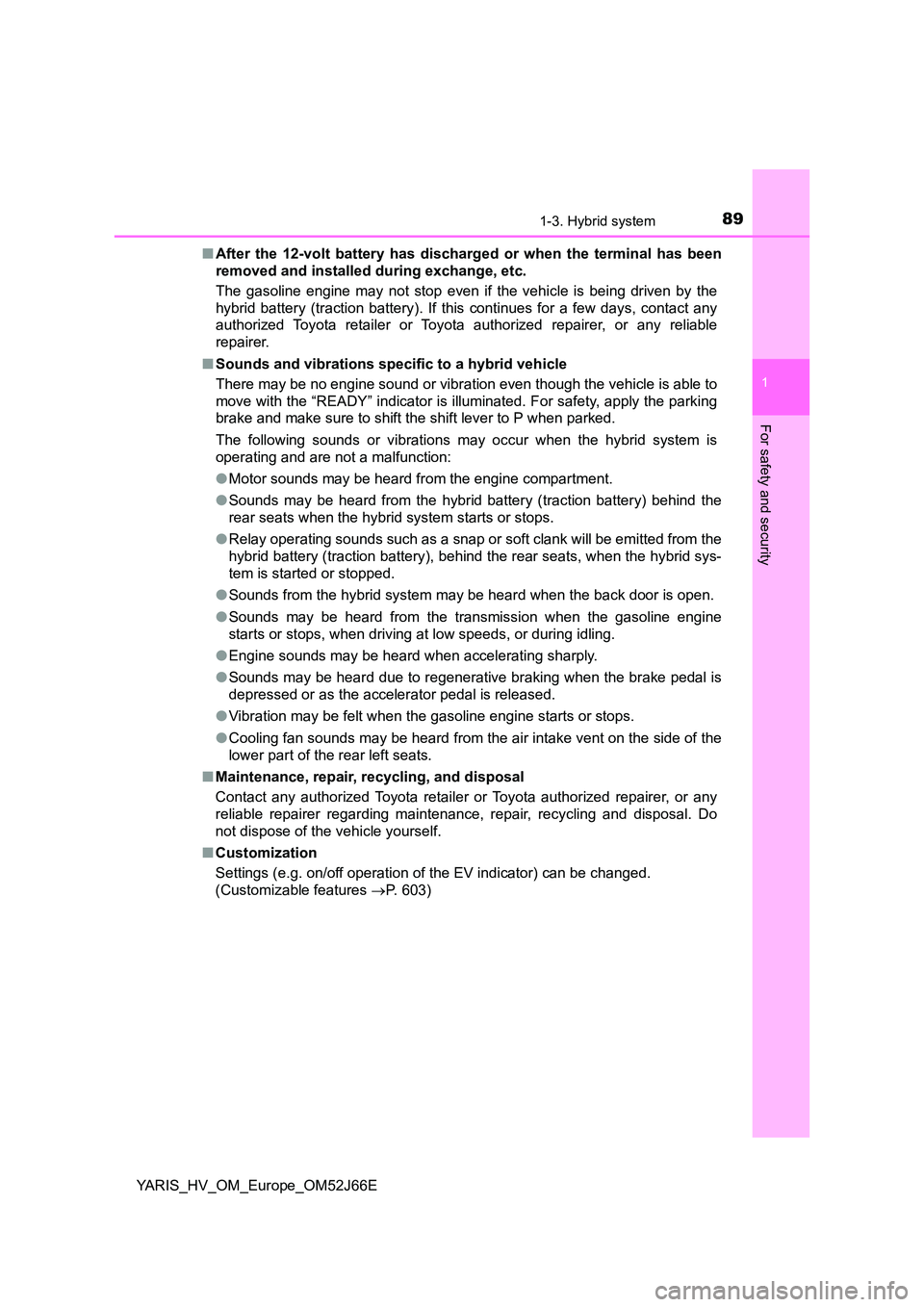
891-3. Hybrid system
1
For safety and security
YARIS_HV_OM_Europe_OM52J66E
■ After the 12-volt battery has discharged or when the terminal has been
removed and installed during exchange, etc.
The gasoline engine may not stop even if the vehicle is being driven by the
hybrid battery (traction battery). If this continues for a few days, contact any
authorized Toyota retailer or Toyota authorized repairer, or any reliable
repairer.
■ Sounds and vibrations specific to a hybrid vehicle
There may be no engine sound or vibration even though the vehicle is able to
move with the “READY” indicator is illuminated. For safety, apply the parking
brake and make sure to shift the shift lever to P when parked.
The following sounds or vibrations may occur when the hybrid system is
operating and are not a malfunction:
● Motor sounds may be heard from the engine compartment.
● Sounds may be heard from the hybrid battery (traction battery) behind the
rear seats when the hybrid system starts or stops.
● Relay operating sounds such as a snap or soft clank will be emitted from the
hybrid battery (traction battery), behind the rear seats, when the hybrid sys-
tem is started or stopped.
● Sounds from the hybrid system may be heard when the back door is open.
● Sounds may be heard from the transmission when the gasoline engine
starts or stops, when driving at low speeds, or during idling.
● Engine sounds may be heard when accelerating sharply.
● Sounds may be heard due to regenerative braking when the brake pedal is
depressed or as the accelerator pedal is released.
● Vibration may be felt when the gasoline engine starts or stops.
● Cooling fan sounds may be heard from the air intake vent on the side of the
lower part of the rear left seats.
■ Maintenance, repair, recycling, and disposal
Contact any authorized Toyota retailer or Toyota authorized repairer, or any
reliable repairer regarding maintenance, repair, recycling and disposal. Do
not dispose of the vehicle yourself.
■ Customization
Settings (e.g. on/off operation of the EV indicator) can be changed.
(Customizable features P. 603)
Page 413 of 632
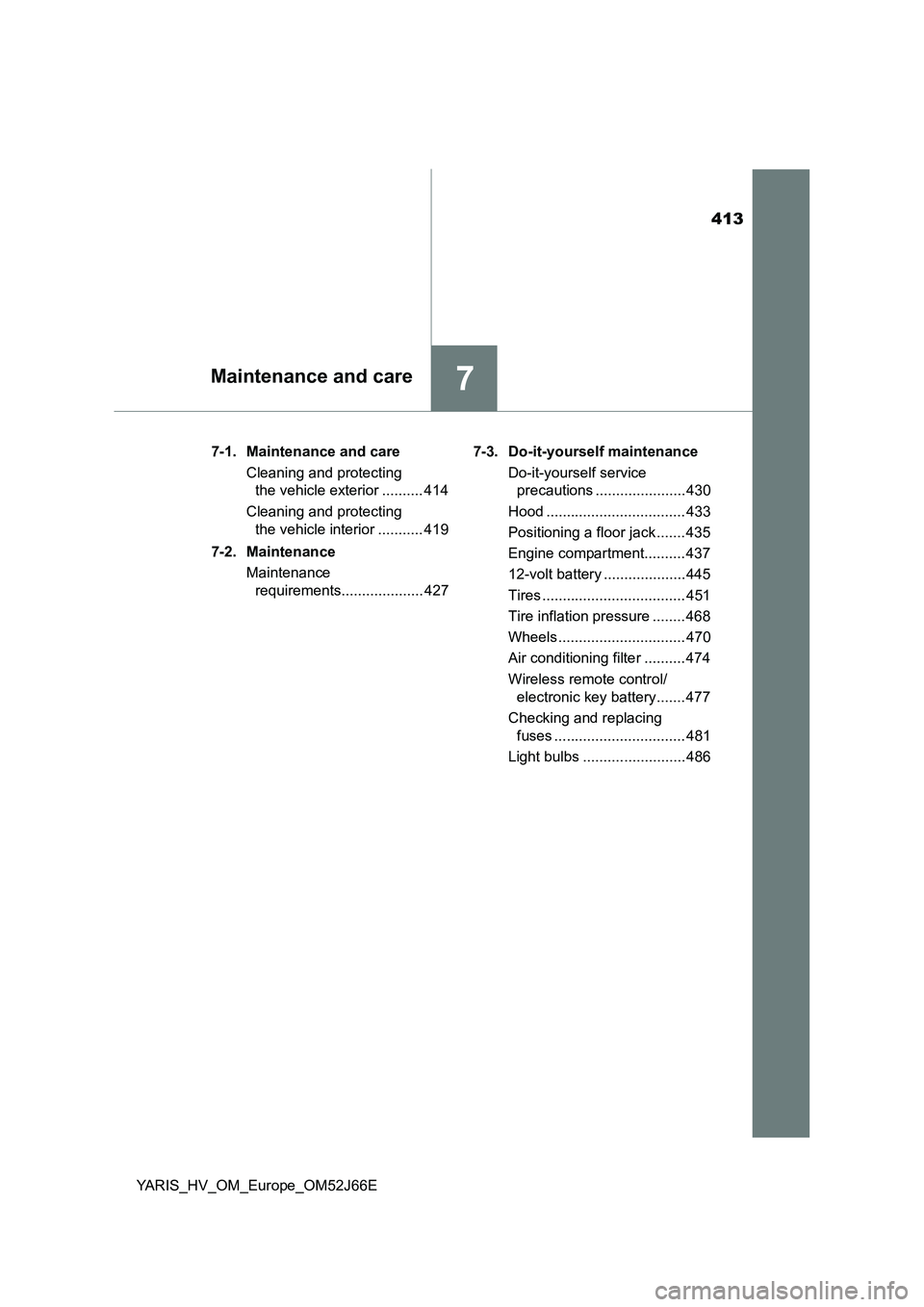
413
7Maintenance and care
YARIS_HV_OM_Europe_OM52J66E
7-1. Maintenance and care
Cleaning and protecting
the vehicle exterior .......... 414
Cleaning and protecting
the vehicle interior ........... 419
7-2. Maintenance
Maintenance
requirements.................... 427
7-3. Do-it-yourself maintenance
Do-it-yourself service
precautions ...................... 430
Hood .................................. 433
Positioning a floor jack ....... 435
Engine compartment.......... 437
12-volt battery .................... 445
Tires ................................... 451
Tire inflation pressure ........ 468
Wheels ............................... 470
Air conditioning filter .......... 474
Wireless remote control/
electronic key battery....... 477
Checking and replacing
fuses ................................ 481
Light bulbs ......................... 486
Page 427 of 632
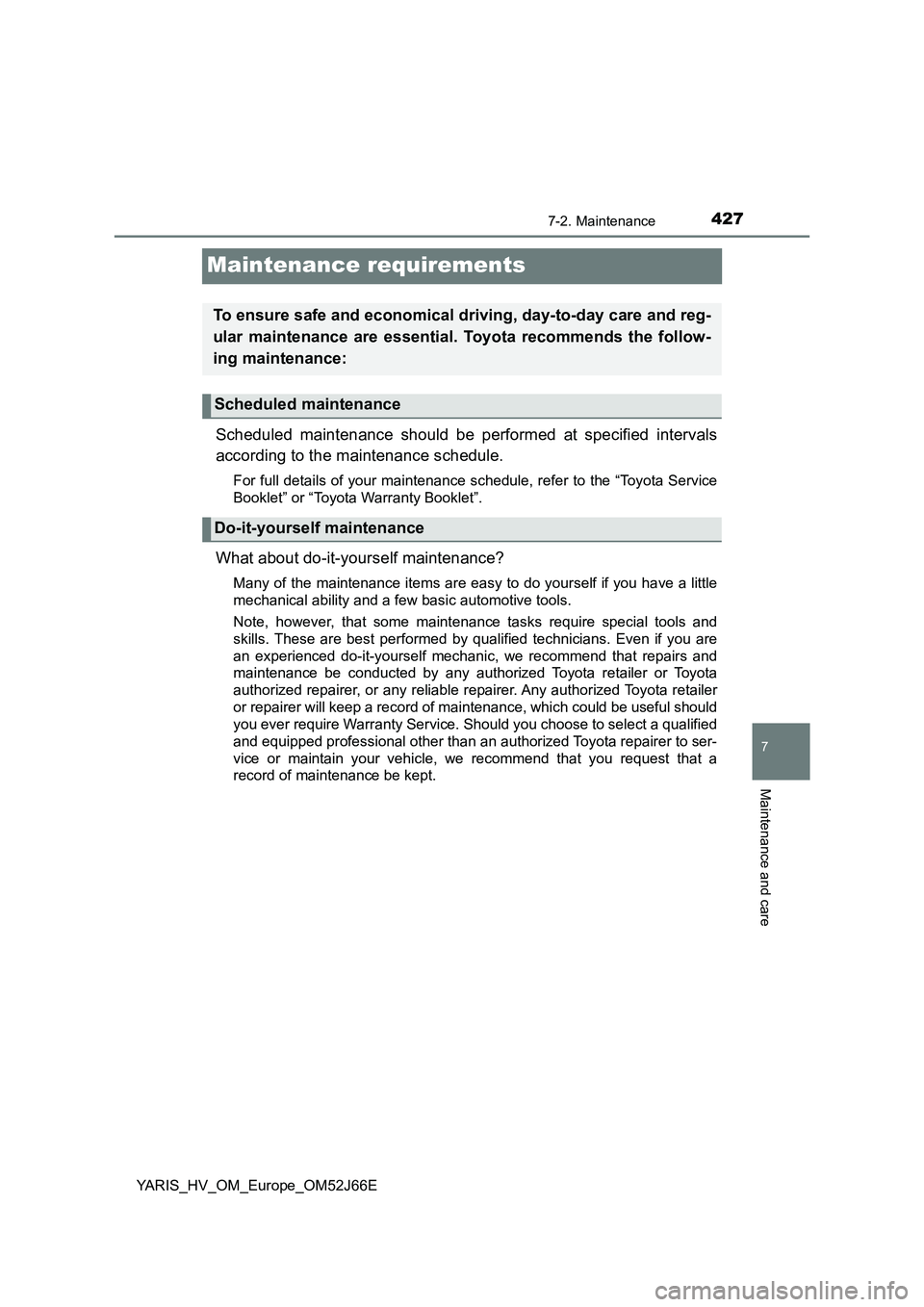
4277-2. Maintenance
7
Maintenance and care
YARIS_HV_OM_Europe_OM52J66E
Maintenance requirements
Scheduled maintenance should be performed at specified intervals
according to the maintenance schedule.
For full details of your maintenance schedule, refer to the “Toyota Service
Booklet” or “Toyota Warranty Booklet”.
What about do-it-yourself maintenance?
Many of the maintenance items are easy to do yourself if you have a little
mechanical ability and a few basic automotive tools.
Note, however, that some maintenance tasks require special tools and
skills. These are best performed by qualified technicians. Even if you are
an experienced do-it-yourself mechanic, we recommend that repairs and
maintenance be conducted by any authorized Toyota retailer or Toyota
authorized repairer, or any reliable repairer. Any authorized Toyota retailer
or repairer will keep a record of maintenance, which could be useful should
you ever require Warranty Service. Should you choose to select a qualified
and equipped professional other than an authorized Toyota repairer to ser-
vice or maintain your vehicle, we recommend that you request that a
record of maintenance be kept.
To ensure safe and economical driving, day-to-day care and reg-
ular maintenance are essential. Toyota recommends the follow-
ing maintenance:
Scheduled maintenance
Do-it-yourself maintenance
Page 430 of 632

4307-3. Do-it-yourself maintenance
YARIS_HV_OM_Europe_OM52J66E
Do-it-yourself service precautions
If you perform maintenance by yourself, be sure to follow the
correct procedure as given in these sections.
ItemsParts and tools
12-volt battery
condition
( P. 445)
• Grease
• Conventional wrench (for terminal clamp bolts)
Engine/power
control unit
coolant level
( P. 441)
• “Toyota Super Long Life Coolant” or a similar high
quality ethylene glycol-based non-silicate, non-
amine, non-nitrite and non-borate coolant with long-
life hybrid organic acid technology
“Toyota Super Long Life Coolant” is pre-mixed with
50% coolant and 50% deionized water.
• Funnel (used only for adding coolant)
Engine oil level
( P. 438)
• “Toyota Genuine Motor Oil” or equivalent
• Rag or paper towel
• Funnel (used only for adding engine oil)
Fuses
( P. 481)• Fuse with same amperage rating as original
Hybrid battery
(traction battery)
cooling air intake
vent
( P. 420)
• Vacuum cleaner
Light bulbs
( P. 486)
• Bulb with same number and wattage rating as origi-
nal
• Phillips-head screwdriver
• Flathead screwdriver•Wrench
Radiator and
condenser
( P. 443)
Tire inflation
pressure
( P. 468)
• Tire pressure gauge
• Compressed air source
Washer fluid
( P. 443)
• Water or washer fluid containing antifreeze (for win-
ter use)
• Funnel (used only for adding water or washer fluid)
Page 431 of 632

4317-3. Do-it-yourself maintenance
7
Maintenance and care
YARIS_HV_OM_Europe_OM52J66E
WARNING
The engine compartment contains many mechanisms and fluids that may
move suddenly, become hot, or become el ectrically energized. To avoid death
or serious injury, observe the following precautions.
■ When working on the engine compartment
● Vehicles without a smart entry & start system: Make sure that the power
switch is in the “LOCK” position and the “READY” indicator are off.
● Vehicles with a smart entry & start system: Make sure that the “Power on”
on the multi-information display and the “READY” indicator are both off.
● Keep hands, clothing and tools away from the moving fan.
● Be careful not to touch the engine, power control unit, radiator, exhaust
manifold, etc., right after driving as they may be hot. Oil and other fluids
may also be hot.
● Do not leave anything that may burn easily, such as paper and rags, in the
engine compartment.
● Do not smoke, cause sparks or expose an open flame to fuel. Fuel fumes
are flammable.
● Take care because brake fluid can harm your hands or eyes and damage
painted surfaces. If fluid gets on your hands or in your eyes, flush the
affected area with clean water immediately.
If you still experience discomfort, consult a doctor.
■ When working near the electric cooling fan or radiator grille
Vehicles without a smart entry & start system
Be sure the power switch is in the “LOCK” position.
With the power switch in the “ON” position, the electric cooling fan may
automatically start to run if the air conditioning is on and/or the coolant tem-
perature is high. ( P. 443)
Vehicles with a smart entry & start system
Be sure the power switch is off.
With the power switch in ON mode, the electric cooling fan may automati-
cally start to run if the air conditioning is on and/or the coolant temperature
is high. ( P. 443)
■ Safety glasses
Wear safety glasses to prevent flying or falling material, fluid spray, etc.,
from getting in your eyes.
Page 432 of 632
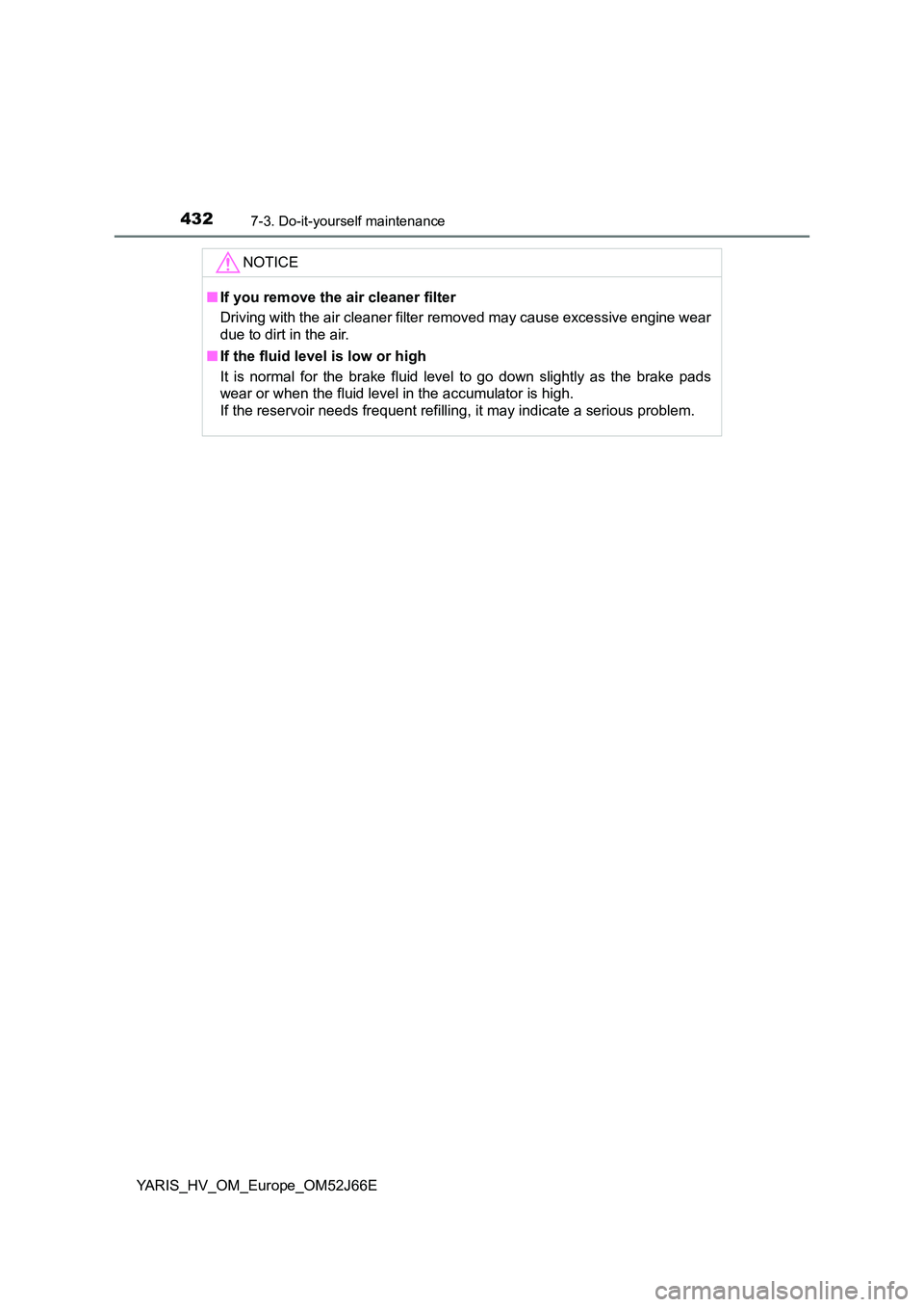
4327-3. Do-it-yourself maintenance
YARIS_HV_OM_Europe_OM52J66E
NOTICE
■If you remove the air cleaner filter
Driving with the air cleaner filter removed may cause excessive engine wear
due to dirt in the air.
■ If the fluid level is low or high
It is normal for the brake fluid level to go down slightly as the brake pads
wear or when the fluid level in the accumulator is high.
If the reservoir needs frequent refilling, it may indicate a serious problem.
Page 433 of 632
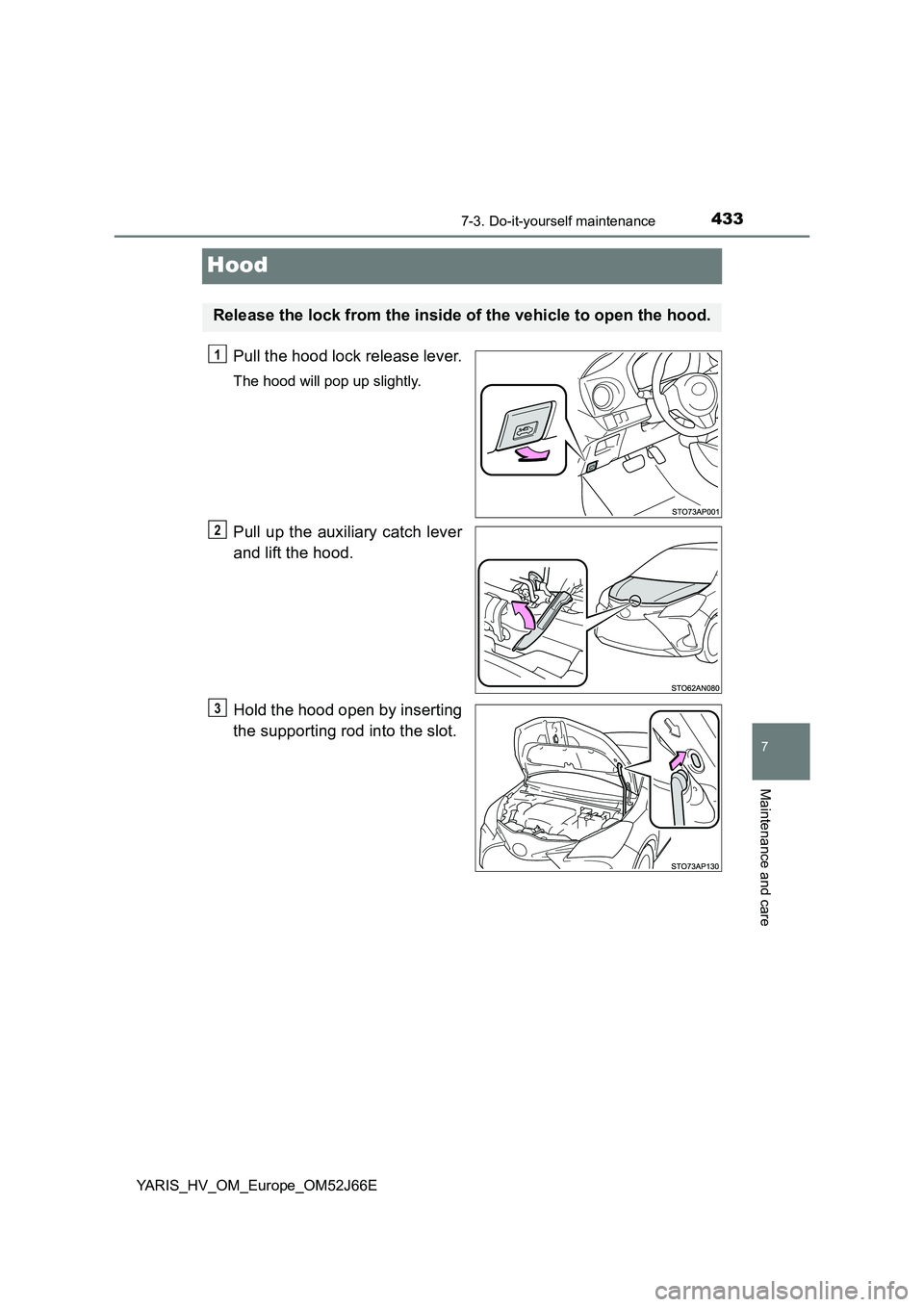
4337-3. Do-it-yourself maintenance
7
Maintenance and care
YARIS_HV_OM_Europe_OM52J66E
Hood
Pull the hood lock release lever.
The hood will pop up slightly.
Pull up the auxiliary catch lever
and lift the hood.
Hold the hood open by inserting
the supporting rod into the slot.
Release the lock from the inside of the vehicle to open the hood.
1
2
3